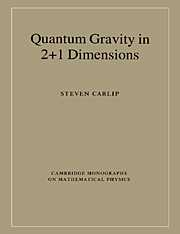Book contents
- Frontmatter
- Contents
- Preface
- 1 Why (2+1)-dimensional gravity?
- 2 Classical general relativity in 2+1 dimensions
- 3 A field guide to the (2+1)-dimensional spacetimes
- 4 Geometric structures and Chern–Simons theory
- 5 Canonical quantization in reduced phase space
- 6 The connection representation
- 7 Operator algebras and loops
- 8 The Wheeler–DeWitt equation
- 9 Lorentzian path integrals
- 10 Euclidean path integrals and quantum cosmology
- 11 Lattice methods
- 12 The (2+1)-dimensional black hole
- 13 Next steps
- Appendix A The topology of manifolds
- Appendix B Lorentzian metrics and causal structure
- Appendix C Differential geometry and fiber bundles
- References
- Index
13 - Next steps
Published online by Cambridge University Press: 15 December 2009
- Frontmatter
- Contents
- Preface
- 1 Why (2+1)-dimensional gravity?
- 2 Classical general relativity in 2+1 dimensions
- 3 A field guide to the (2+1)-dimensional spacetimes
- 4 Geometric structures and Chern–Simons theory
- 5 Canonical quantization in reduced phase space
- 6 The connection representation
- 7 Operator algebras and loops
- 8 The Wheeler–DeWitt equation
- 9 Lorentzian path integrals
- 10 Euclidean path integrals and quantum cosmology
- 11 Lattice methods
- 12 The (2+1)-dimensional black hole
- 13 Next steps
- Appendix A The topology of manifolds
- Appendix B Lorentzian metrics and causal structure
- Appendix C Differential geometry and fiber bundles
- References
- Index
Summary
The universe in which we live is not (2+1)-dimensional, and the quantum theories described in this book are not realistic models of physics. Nor is (2+1)-dimensional quantum gravity fully understood; as I have tried to emphasize, many deep questions remain open. Nevertheless, the models developed in the preceding chapters can offer us some useful insights into realistic quantum gravity.
Perhaps the most important role of (2+1)-dimensional quantum gravity is as an ‘existence theorem’, a demonstration that general relativity can be quantized without any new ingredients. This is by no means trivial: there has long been a suspicion that quantum gravity would require a radical change in general relativity or quantum mechanics. While this may yet be true in 3+1 dimensions, the (2+1)-dimensional models suggest that no such revolutionary overhaul of known physics is needed. This does not mean that our existing frameworks are correct, of course, but it makes it less likely that major changes will come merely from the need to quantize gravity.
At the same time, (2+1)-dimensional quantum gravity serves as a sort of ‘nonuniqueness theorem’. We have seen that there are many ways to quantize general relativity in 2+1 dimensions, and that not all of them lead to equivalent theories. This is perhaps not surprising, but it is a bit disappointing: in the absence of clear experimental tests of quantum gravity, there has been a widely held (although often unspoken) hope that the requirement of self-consistency might be enough to guide us to the correct formulation.
- Type
- Chapter
- Information
- Quantum Gravity in 2+1 Dimensions , pp. 212 - 216Publisher: Cambridge University PressPrint publication year: 1998

